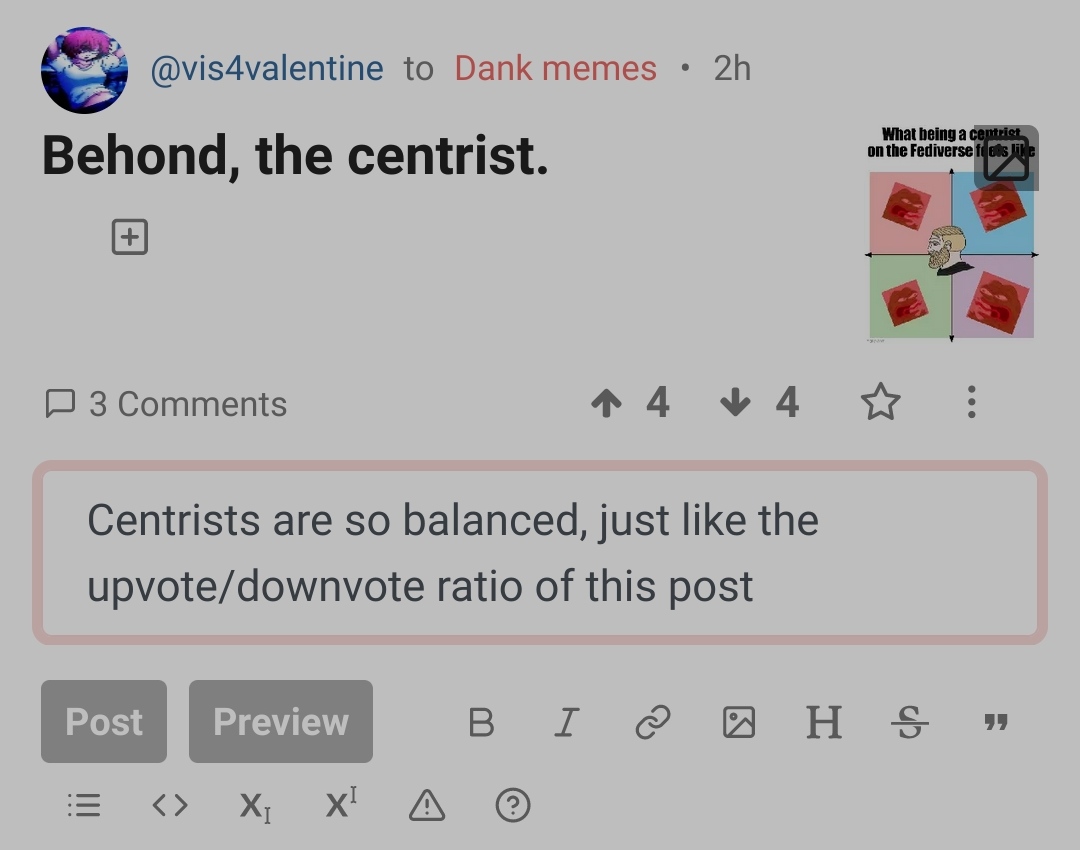Esperanto is still eurocentric. That is, it is only easy to learn because you already know English, and perhaps another European language. Lojban or toki pona would be a better option.
One of the few I can enjoy is Boney M's Daddy Cool. Had to endure it for hours on a trip so I guess I had to enjoy it as a defense mechanism.
Be chronologically correct and use the right logo, pal

Wtf supporting environmental causes is extremist now?
Centrists are so balanced, just like the upvote/downvote ratio of this post. It also has 4 comments at the time I wrote this.

BookWyrm is a secondary source, so I don't think it's a good idea. Personally, I'd link to:
- The book's website, if there is (which usually just links to amazon)
- Wikipedia page
- OpenLibrary
As for where to buy books, I've recently heard of Libreture, which have DRM-free books (see other DRM-free book source), though its database might be lacking because it's rather new.

The text on the right is the title text.
Gloss
(Lemmy parsed these dotted gloss as links, smh)
Ponytail: ! this-prize-nom.mt.sg Nobel-gen.mt.sg you-dat.wo.sg we\_exclusive-nom.plaward-ind.prs.prf
Hairy: ! that-nom.sg be-ind.prs.cnt rock-nom.ea.sg
Ponytail: . yes but if you-nom.wo.sg look-sub.prs.prf other-angle-abl.mt.sg,
Text:
. NASA start-ind.prs.prf award new-prize-acc.mt.sg people-dat.ea.plwho-nom.pl say-ind.prs.prf world-computer-net-dat.mt.sg infind life.acc.wo.sg fire-star-gen.fi.sg number-picture-dat.fi.pl
Title text:
. fire-star-gen.fi.sg life-acc.wo.sg find-gen.ea.sg to\_purpose,make-sub.prs.prf picture-machine-acc.mt.sg and it-acc.mt.sg send-sub.prs.prffire-star-dat.fi.sg . that-when-dat after search\_for-sub.prs.prfdog-acc.ea.pl and plant-acc.wo.pl picture-dat.fi.pl in
Translation note:
- NASA is an organization so its name isn't translated if not necessary.
- "Mars" whose translation is literally "Fire star", is a calque from Chinese
- "Photo" is literally "digital picture". Normally, this distinction is not important, but in this case it is to emphasize it is not a drawing. "Digital" is also a calque.
Pronunciation
Note for tones:
- level tone (a): /˧˧/
- rising tone (á): /˧˥/
- falling tone (à): /˥˩/
/ki.dúɲ.ga.so nu.bel.ko lúk.da rèχ.sə˧˥ χaːs.wú.ʔa//las wí.tar goŋ.si//daː gai̯.ʔa χaːswúz səŋ.dúɲ.ga.no lìmdí də baŋ.sì zaː tanaːŋ.dè.leː χan.ner.moχ.do jos dák.zə siː.vəl.men.na raː.té.reŋ.keva.lu.ɣós.meŋ.de jos//raː.té.reŋ.ke siː.vəl.men.na dák.ki jaɲ daʊ̯.ʔu ɣós.meŋ.χó.no nòːrtèn.no siː.pu raːtéːreŋ.de//la.hip.də mús.neχ dá cu wuːp.ni nòːr daːn.rá.na ɣós.meŋ.dé jos/
Grammar
Some notable features:
- 5 genders, named after the five phases in wǔxíng.
- Sentence punctuation is at the beginning.
- A glyph structure similar to Korean: built from individual letters.
- Agglutinative and has vowels, consonants, and tones as inflection unit.